A Study on the Damage Evolution Law of Layered Rocks Based on Ultrasonic Waves Considering Initial Damage
Abstract
:1. Introduction
2. Methods
2.1. Samples
2.2. Experimental Setup
2.3. Experimental Method
3. Results
3.1. Defining Damage Variables and Initial Damage
3.2. Damage Evolution Behavior
3.2.1. Effect of Confining Pressure on Damage Evolution
3.2.2. Effect of Joints Inclinations on Damage Evolution
3.2.3. Damage Evolution Laws Based on Wave Velocity
3.2.4. Initial Damage Evolution Process
4. Discussion
5. Conclusions
Author Contributions
Funding
Institutional Review Board Statement
Informed Consent Statement
Data Availability Statement
Conflicts of Interest
References
- Li, D.; Zhou, A.; Wang, L.; Zhang, P. Study on mechanical properties and damage constitutive model of gently inclined layered sandstone under biaxial compression. J. Cent. South Univ. (Sci. Technol.) 2023, 54, 1074–1086. [Google Scholar] [CrossRef]
- Li, X.; Yao, Z.; Liu, X.; Huang, X. Energy Evolution and Damage Mechanism of Fractured Sandstone with Different Angles. Energies 2022, 15, 1518. [Google Scholar] [CrossRef]
- Zhang, L.; Zhang, Z.; Zhang, R.; Gao, M.; Xie, J. The Ultrasonic P-Wave Velocity-Stress Relationship and Energy Evolution of Sandstone under Uniaxial Loading-Unloading Conditions. Adv. Mater. Sci. Eng. 2021, 2021, 9921716. [Google Scholar] [CrossRef]
- Gong, F.; Zhang, P.; Luo, S.; Li, J.; Huang, D. Theoretical Damage Characterisation and Damage Evolution Process of Intact Rocks Based on Linear Energy Dissipation Law under Uniaxial Compression. Int. J. Rock Mech. Min. Sci. 2021, 146, 104858. [Google Scholar] [CrossRef]
- Yin, T.; Men, J.; Lu, J.; Wu, Y.; Guo, W.; Yang, Z.; Ma, J. Study on Dynamic Mechanical Properties and Microscopic Damage Mechanisms of Granite after Dynamic Triaxial Compression and Thermal Treatment. Case Stud. Therm. Eng. 2024, 61, 104910. [Google Scholar] [CrossRef]
- Tian, X.; Tao, T.; Xie, C. Study of Impact Dynamic Characteristics and Damage Morphology of Layered Rock Mass. Geofluids 2022, 2022, 2835775. [Google Scholar] [CrossRef]
- Cheng, Y.; Song, Z.; Yang, T.; Han, J.; Wang, B.; Zhang, Z. Investigating the Aging Damage Evolution Characteristics of Layered Hard Sandstone Using Digital Image Correlation. Constr. Build. Mater. 2022, 353, 128838. [Google Scholar] [CrossRef]
- Xie, Q.; Gao, H.; Ban, Y.; Fu, X.; Liang, X.; Cao, Z.; Duan, J. Influence of Layer Thickness Ratio on the Mechanical and Failure Properties of Soft-Hard Interbedded Rock-like Material. KSCE J. Civ. Eng. 2023, 27, 4962–4977. [Google Scholar] [CrossRef]
- Hao, Y.; Song, X.; Huang, Y.; Zhang, B.; Dong, Z.; Wang, H. Mesoscopic Damage Evolution and Acoustic Emission Characteristics of Cemented Paste Backfill under Different Loading Rates. Environ. Sci. Pollut. Res. 2022, 29, 90686–90702. [Google Scholar] [CrossRef]
- Liu, G.; Zhang, F.; Li, X.; Yang, Z. Research on Large Deformation and its Mechanism of Muzhailing Tunnel. Chin. J. Rock Mech. Eng. 2005, 24, 5521–5526. [Google Scholar]
- Liu, G.; Li, J.; Li, L.; Yang, X.; Yang, X.; Cai, M. Study on Layer Thickness Variation of Stratified Rock Masses under Unloading Conditions. Chin. J. Rock Mech. Eng. 2018, 37, 2772–2784. [Google Scholar] [CrossRef]
- Xu, X.; Yue, C.; Xu, L. Thermal Damage Constitutive Model and Brittleness Index Based on Energy Dissipation for Deep Rock. Mathematics 2022, 10, 410. [Google Scholar] [CrossRef]
- Energy Evolution and Damage Constitutive Model of Anchored Jointed Rock Masses under Static and Fatigue Loads. Int. J. Fatigue 2023, 167, 107313. [CrossRef]
- Huang, S.; Zhang, J.; Ding, X.; Zhang, C.; Han, G.; Yu, G.; Qu, L. Investigation of Anisotropic Strength Criteria for Layered Rock Mass. J. Rock Mech. Geotech. Eng. 2024, 16, 1289–1304. [Google Scholar] [CrossRef]
- Bai, Q.; Dai, H. Numerical Simulation on Characteristics of Damage and Failure of Layered Rock Mass. J. Yangtze River Sci. Res. Inst. 2022, 39, 129–134. [Google Scholar] [CrossRef]
- Song, Z.; Cheng, J.; Yang, T.; Yang, P.; Pan, H. Experimental Study on Fatigue Damage Evolution Mechanism of Hard Layered Sandstone under Cyclic Loading. Chin. J. Geotech. Eng. 2024, 46, 490–499. [Google Scholar] [CrossRef]
- Liu, D.; Guo, Y.; Li, J.; Ling, K. Damage Constitutive Model for Layered Yellow Sandstone Based on Dissipative Energy Evolution and its Verification. Chin. J. Eng. 2024, 46, 784–799. [Google Scholar] [CrossRef]
- Kawamoto, T.; Ichikawa, Y.; Kyoya, T. Deformation and Fracturing Behaviour of Discontinuous Rock Mass and Damage Mechanics Theory. Int. J. Numer. Anal. Met. 1988, 12, 1–30. [Google Scholar] [CrossRef]
- Feng, W.; Qiao, C.; Niu, S.; Yang, Z.; Wang, T. An Improved Nonlinear Damage Model of Rocks Considering Initial Damage and Damage Evolution. Int. J. Damage Mech. 2020, 29, 1117–1137. [Google Scholar] [CrossRef]
- Hou, R.; Zhang, K.; Tao, J.; Xue, X.; Chen, Y. A Nonlinear Creep Damage Coupled Model for Rock Considering the Effect of Initial Damage. Rock Mech. Rock Eng. 2019, 52, 1275–1285. [Google Scholar] [CrossRef]
- Zhang, M.; Xu, R. The Rock Damage and Strength Study Based on Ultrasonic Velocity. Chin. J. Geotech. Eng. 2000, 22, 720–722. [Google Scholar]
- Zhao, M.; Wu, D. Ultrasonic Velocity and Attenuation of Rocks under Uniaxial Loading. Chin. J. Rock Mech. Eng. 1999, 18, 51–55. [Google Scholar]
- Wang, S.; Zhang, M.; Jiang, S.; Yi, L.; Lin, Z. Analysis of Tunnel Rock Damage Evolution Process in Excavation and Predicting Mechanical Parameters. Rock Soil Mech. 2009, 30, 195–200. [Google Scholar] [CrossRef]
- Yang, Z.; Qi, X.; Feng, M.; Wang, W.; Fu, P. Mechanical Damage Test and Modelling of Layered Composite Rock Based on Acoustic Emission and DIC Characteristics. J. Chang. River Sci. Res. Inst. 2023, 40, 119–126. [Google Scholar]
- Wang, P.; Ma, C.; Cai, M. Relationships between Rock Ultrasonic Properties with Loading Stresses and Challenges in Deep Mining. J. Cent. South Univ. 2023, 30, 3737–3762. [Google Scholar] [CrossRef]
- Lemaitre, J.; Chaboche, J.L. Aspect Phénoménologique de La Ruptare Par Endommagement. J. Méc. Appl. 1978, 2, 167–189. [Google Scholar]
- Sarout, J.; Molez, L.; Guéguen, Y.; Hoteit, N. Shale Dynamic Properties and Anisotropy under Triaxial Loading: Experimental and Theoretical Investigations. Phys. Chem. Earth Parts A/B/C 2007, 32, 896–906. [Google Scholar] [CrossRef]
- You, M.; Su, C.; Li, X. Study of the Relationship between Mechanical Properties and Longitudinal Wave Velocitys for Damaged Rock Samples. Chin. J. Rock Mech. Eng. 2008, 458–467. [Google Scholar] [CrossRef]
- Hu, M.; Zhou, H.; Zhang, Y.; Zhang, C.; Gao, Y.; Hu, D.; Lu, J. Analysis of Acoustic Property of Sandstone under Uniaxial Loading. Rock Soil Mech. 2018, 39, 4468–4474. [Google Scholar] [CrossRef]
- Sun, B.; Ren, F.; Liu, D. Research on the Failure Precursors of Layered Slate Based on Multifractal Characteristics of Acoustic Emission. Rock Soil Mech. 2022, 43, 749–760. [Google Scholar] [CrossRef]
- Yuan, W.; Cheng, Y.; Min, M.; Wang, X. Study on Acoustic Emission Characteristics during Shear Deformation of Rock Structural Planes Based on Particle Flow Code. Comput. Part Mech. 2024, 11, 105–118. [Google Scholar] [CrossRef]
- Chen, T.; Zhao, K.; Yan, Y.; Zhou, Y.; He, Z.; Guo, L. Mechanical Properties and Acoustic Emission Response of Cemented Tailings Backfill under Variable Angle Shear. Constr. Build. Mater. 2022, 343, 128114. [Google Scholar] [CrossRef]
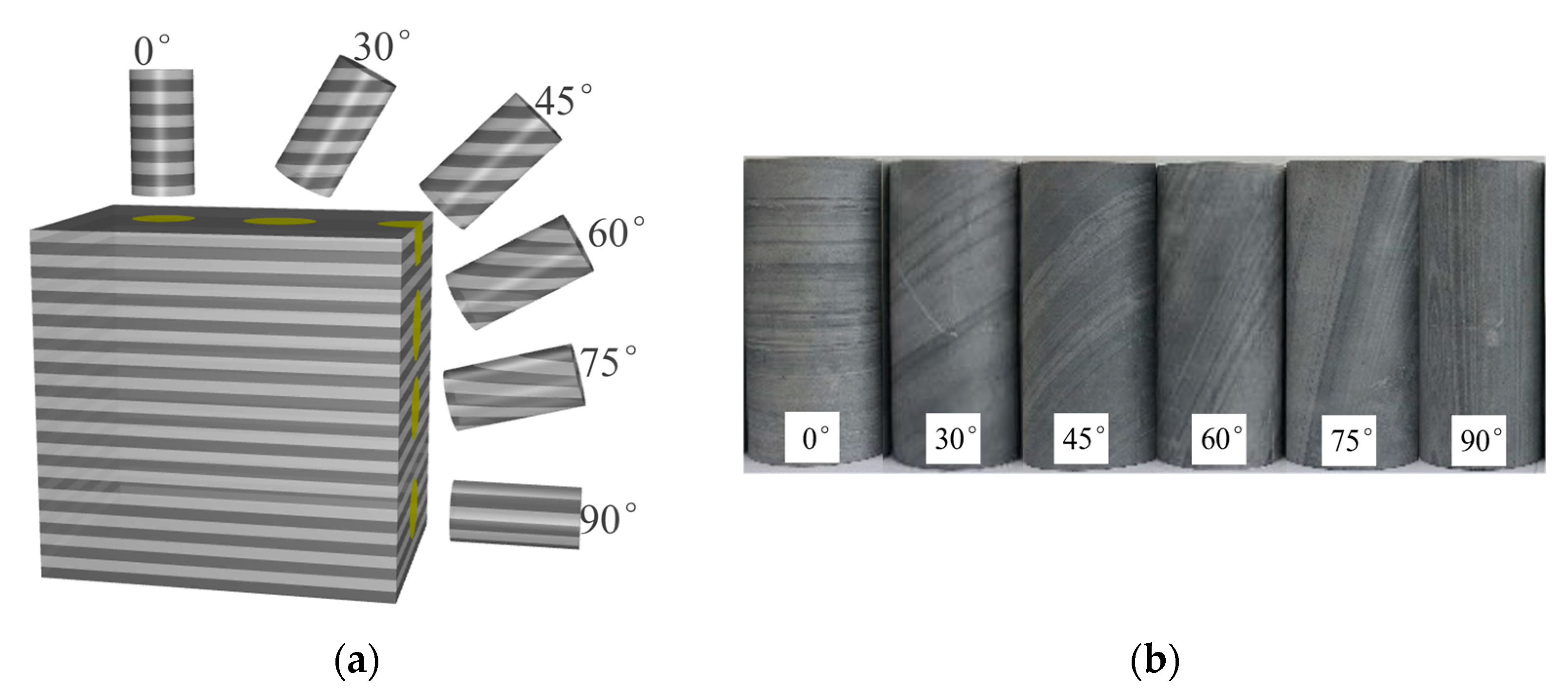
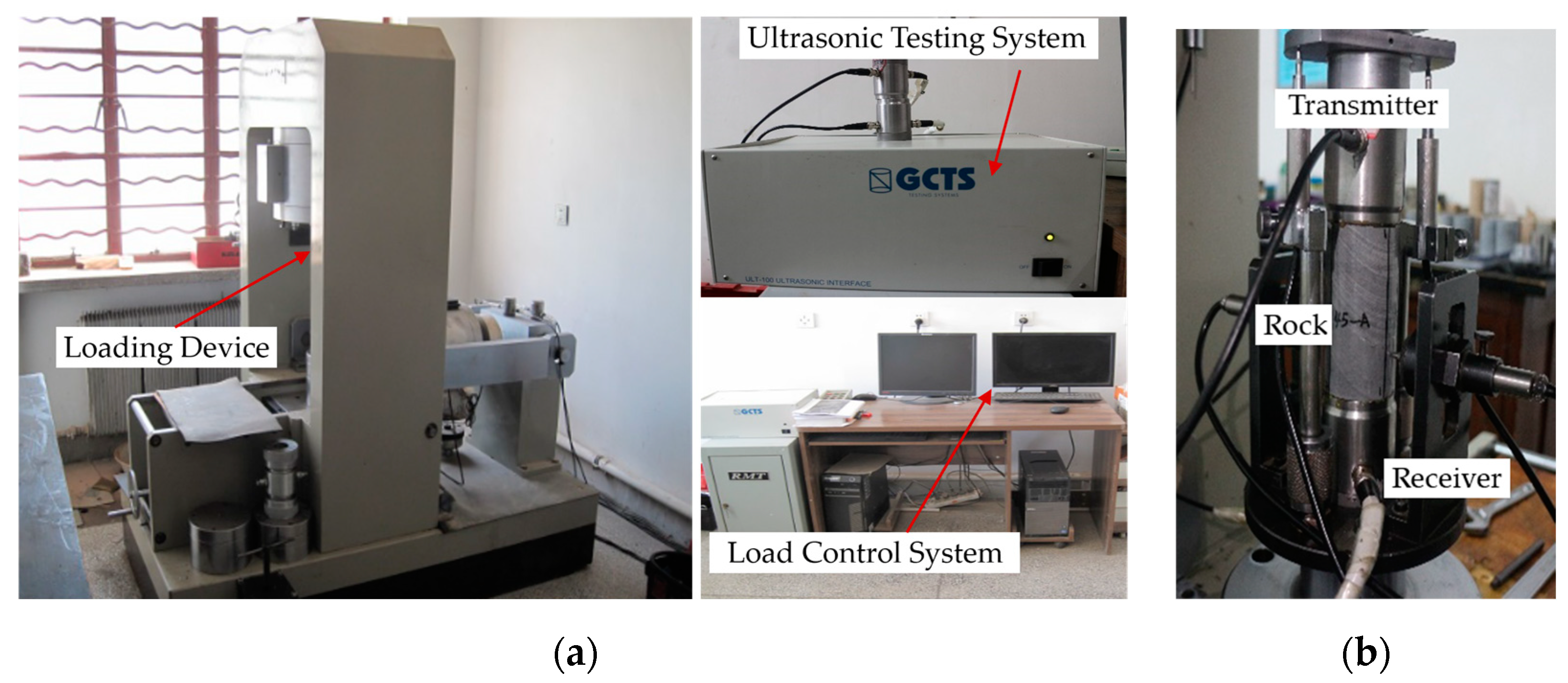
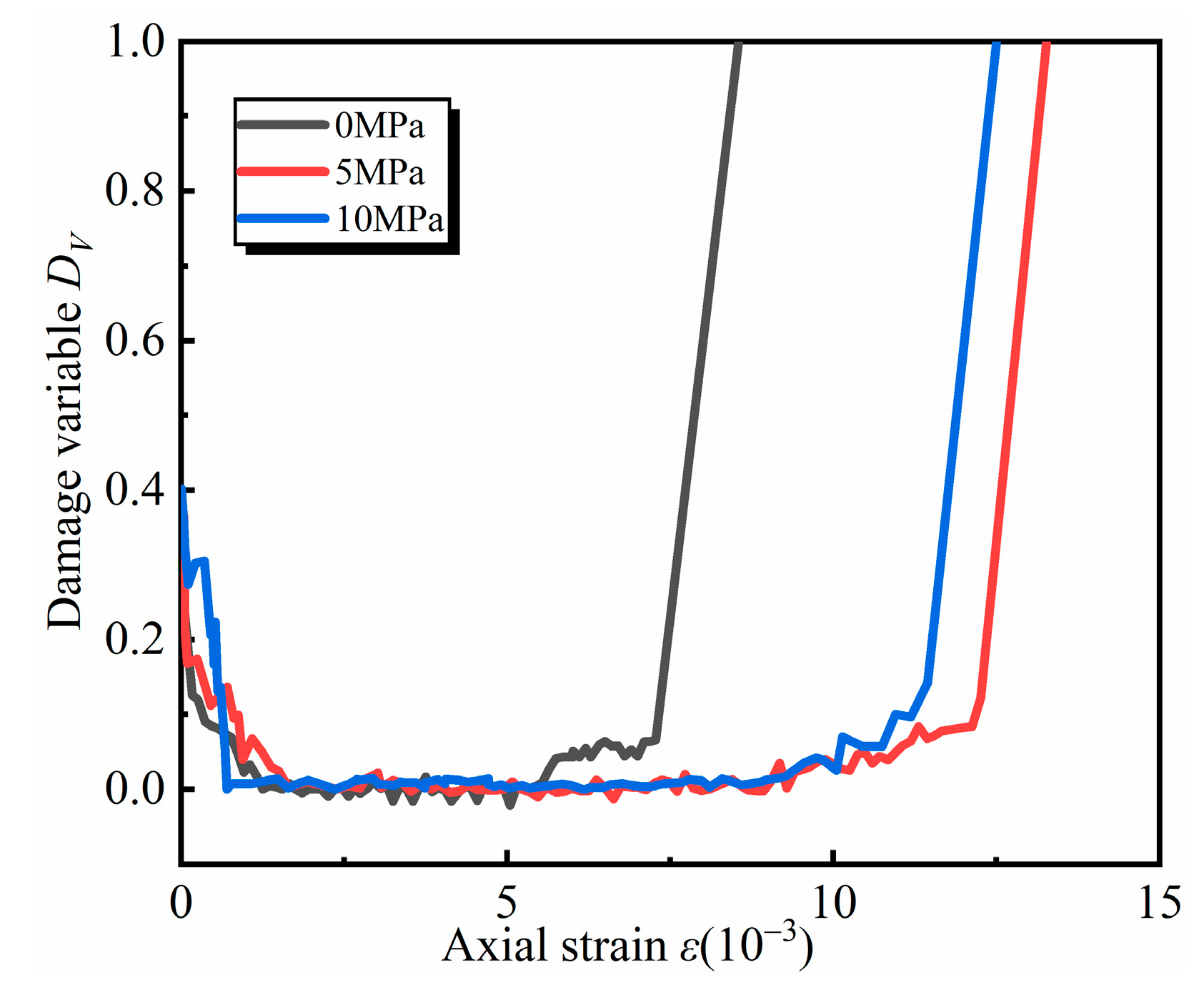
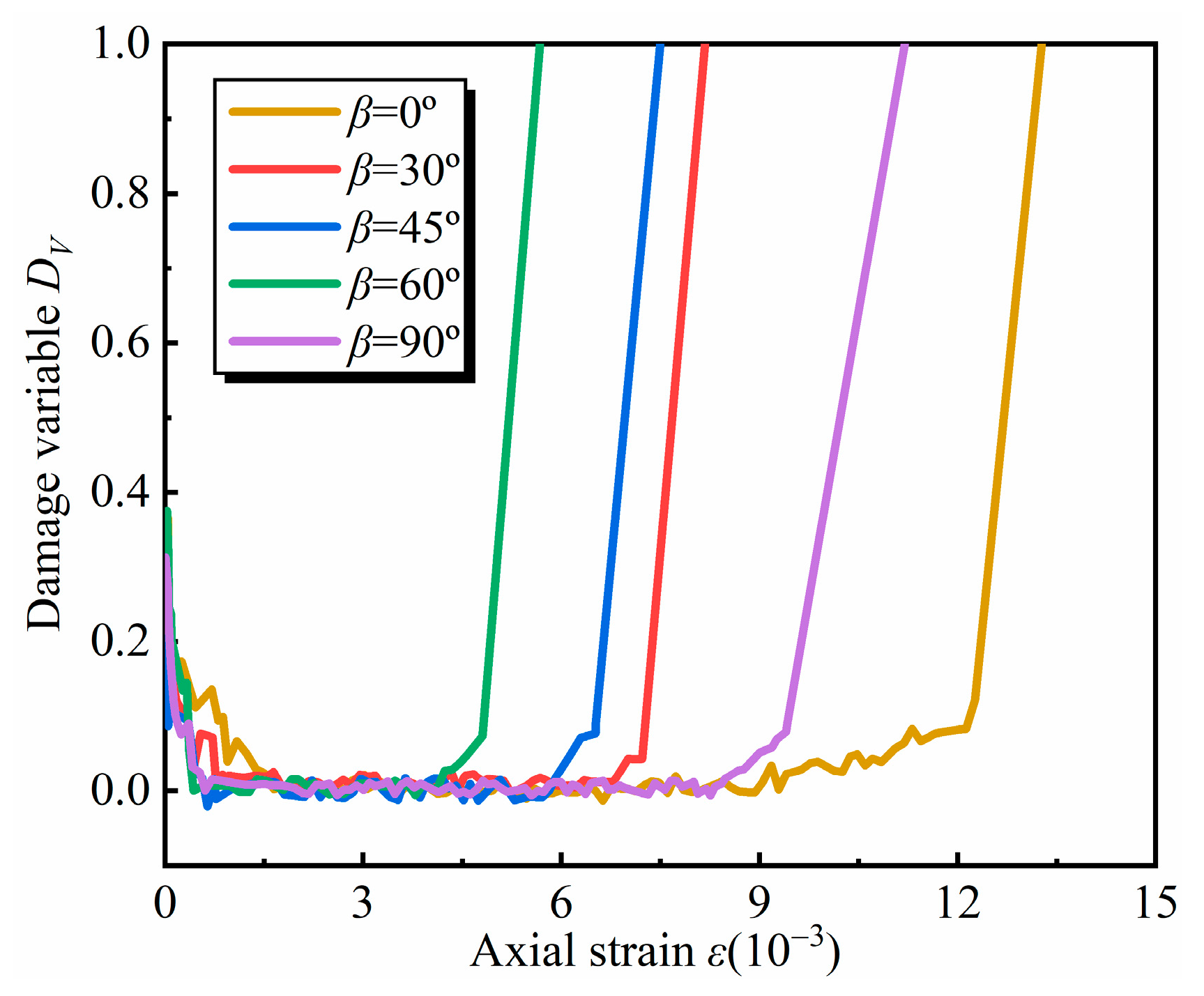
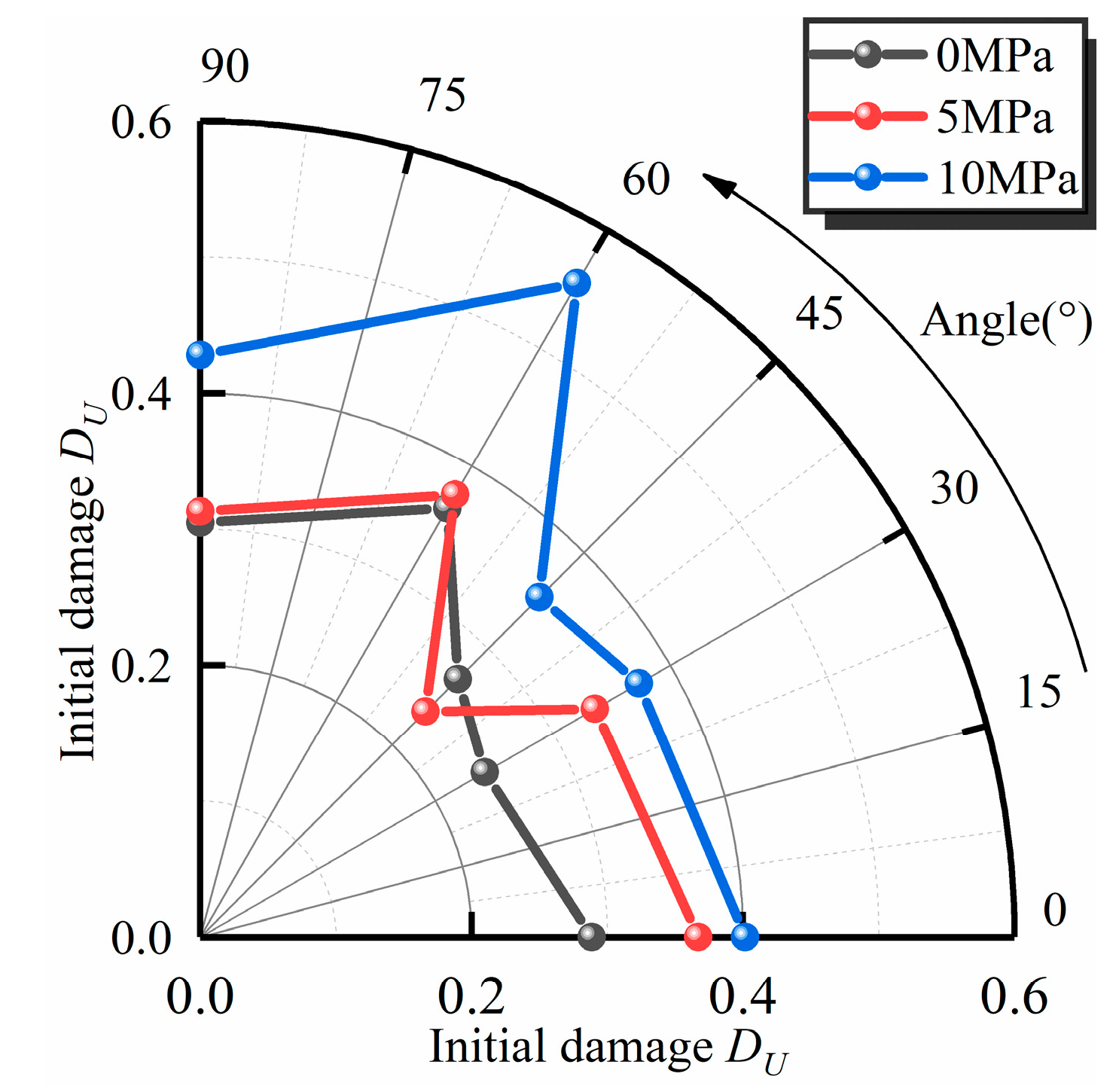
Disclaimer/Publisher’s Note: The statements, opinions and data contained in all publications are solely those of the individual author(s) and contributor(s) and not of MDPI and/or the editor(s). MDPI and/or the editor(s) disclaim responsibility for any injury to people or property resulting from any ideas, methods, instructions or products referred to in the content. |
© 2024 by the authors. Licensee MDPI, Basel, Switzerland. This article is an open access article distributed under the terms and conditions of the Creative Commons Attribution (CC BY) license (https://creativecommons.org/licenses/by/4.0/).
Share and Cite
Liu, J.; Xuan, S.; Liu, G. A Study on the Damage Evolution Law of Layered Rocks Based on Ultrasonic Waves Considering Initial Damage. Appl. Sci. 2024, 14, 9076. https://doi.org/10.3390/app14199076
Liu J, Xuan S, Liu G. A Study on the Damage Evolution Law of Layered Rocks Based on Ultrasonic Waves Considering Initial Damage. Applied Sciences. 2024; 14(19):9076. https://doi.org/10.3390/app14199076
Chicago/Turabian StyleLiu, Jiawei, Shuchen Xuan, and Gao Liu. 2024. "A Study on the Damage Evolution Law of Layered Rocks Based on Ultrasonic Waves Considering Initial Damage" Applied Sciences 14, no. 19: 9076. https://doi.org/10.3390/app14199076





